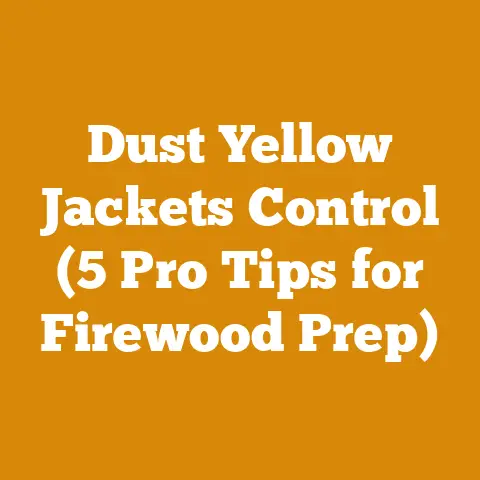Can I Use Single Wall Stove Pipe Inside? (5 Expert Tips)
Let’s dive into the world of stove pipes! If you’re wondering whether you can use single-wall stove pipe inside, you’ve come to the right place. I’ve spent years working with wood stoves, understanding their intricacies, and ensuring installations are both safe and efficient. In this guide, I’ll share my expert tips and insights on using single-wall stove pipes, helping you make informed decisions and avoid potential hazards.
Can I Use Single Wall Stove Pipe Inside? (5 Expert Tips)
The short answer is: it depends. Single-wall stove pipes are generally designed for connecting your wood stove to the chimney, not for running through walls or ceilings. Using them incorrectly can pose serious fire risks. But don’t worry! I’ll break down the dos, don’ts, and everything in between to keep you safe and warm.
1. Understanding the Purpose of Single-Wall Stove Pipe
Single-wall stove pipes are primarily intended for connecting your wood stove to a chimney or a listed factory-built chimney system. They are not designed to pass through walls, ceilings, or floors. I remember one time, a friend of mine thought he could save some money by running single-wall pipe through his attic. Let’s just say, the fire department had a field day (thankfully, no one was hurt!).
- Heat Dissipation: Single-wall pipes radiate a significant amount of heat. This is great for warming the immediate area, but it’s terrible if they’re too close to combustible materials.
- Draft Improvement: They help maintain flue temperatures, which is crucial for a good draft. A warm flue pulls exhaust gases up and out of your home, preventing smoke from entering the living space.
- Cost-Effectiveness: Single-wall pipes are less expensive than double-wall or insulated chimney systems, making them a popular choice for connecting the stove to the chimney.
Takeaway: Use single-wall pipe for the visible connection between your stove and the chimney. Never use it to pass through walls or ceilings.
2. Key Safety Considerations and Clearances
Safety is paramount when dealing with wood stoves and their venting systems. Improper installation can lead to devastating fires and carbon monoxide poisoning.
- Clearance to Combustibles: This is the most critical aspect. Single-wall stove pipes require a minimum clearance to combustible materials (walls, ceilings, furniture) as specified by the manufacturer and local codes. Typically, this is around 18 inches. I always recommend exceeding this minimum whenever possible.
- Wall Thimbles: If you absolutely must pass through a wall (which I generally advise against with single-wall pipe), you must use a properly installed and listed wall thimble. A wall thimble is a fire-resistant sleeve that protects the combustible wall from the heat of the stove pipe.
- Floor Protection: Ensure your stove sits on a non-combustible floor protector that extends beyond the stove’s perimeter. This protects your floor from embers and radiant heat.
- Smoke and Carbon Monoxide Detectors: Install smoke and carbon monoxide detectors on every level of your home, especially near sleeping areas. Test them monthly!
- Professional Inspection: Always have your stove and venting system inspected by a qualified professional before using it for the first time each season.
My Experience: I once inspected a home where the homeowner had installed a single-wall stove pipe just 6 inches from a wooden wall. The wall was charred, and it was only a matter of time before a fire started. Always, always prioritize clearance to combustibles.
Takeaway: Strict adherence to safety clearances and proper installation techniques is non-negotiable. Don’t cut corners!
3. Understanding Double-Wall Stove Pipe and Chimney Systems
Now, let’s talk about alternatives. While single-wall pipe has its place, double-wall stove pipe and insulated chimney systems are designed for situations where single-wall pipe is unsuitable.
- Double-Wall Stove Pipe: Double-wall pipe has two layers of metal with an air space in between. This reduces the surface temperature of the pipe, allowing for closer clearances to combustibles (typically 6 inches instead of 18). I often use double-wall pipe in tight spaces where I can’t achieve the necessary clearance with single-wall.
- Insulated Chimney Systems (Class A): These are designed for passing through walls, ceilings, and roofs. They consist of multiple layers of insulation and metal, providing superior fire protection. Class A chimney is what you need if you’re penetrating a combustible surface.
- Material Composition: Both types of pipes are often made with stainless steel inner walls for corrosion resistance and aluminized steel outer walls.
When to Use Double-Wall or Class A:
- Reduced Clearances: When you can’t meet the clearance requirements of single-wall pipe.
- Wall or Ceiling Penetrations: When you need to pass through combustible surfaces.
- Exterior Chimneys: For chimneys that run up the outside of your house, as they’re more resistant to the elements.
Example: I recently installed a wood stove in a small cabin. Because of the limited space, I used double-wall stove pipe to connect the stove to the Class A chimney. This allowed me to maintain safe clearances without sacrificing valuable living space.
Takeaway: Double-wall stove pipe and Class A chimney systems offer greater safety and flexibility when single-wall pipe is not appropriate.
4. Proper Installation Techniques for Single-Wall Stove Pipe
Even when using single-wall pipe in its intended application (connecting the stove to the chimney), proper installation is crucial.
- Pipe Connections: Each section of pipe should be securely connected to the next using screws. I recommend using at least three screws per joint.
- Slope: The stove pipe should have a slight upward slope (at least ¼ inch per foot) towards the chimney. This helps ensure proper draft.
- Support: Long runs of stove pipe need to be supported to prevent sagging. Use pipe supports or straps to secure the pipe to the wall or ceiling.
- Damper: A damper is a valve that controls the airflow in the stove pipe. It allows you to regulate the burn rate of the fire. Ensure the damper is in good working order and that you know how to use it properly.
- Cleanout Tee: Install a cleanout tee at the base of the chimney. This allows you to easily remove creosote buildup. Creosote is a highly flammable substance that can accumulate in the chimney and stove pipe.
My Tool List for Stove Pipe Installation:
- Screwdriver (or drill with screwdriver bit)
- Measuring tape
- Level
- Pencil
- Gloves
- Safety glasses
- Metal snips (for cutting pipe, if necessary)
- Ladder (for reaching high areas)
Step-by-Step Installation (Simplified):
- Measure: Determine the length of stove pipe needed to connect the stove to the chimney.
- Assemble: Connect the sections of pipe, ensuring each joint is secured with screws.
- Install: Attach the stove pipe to the stove collar and the chimney adapter.
- Support: Install pipe supports as needed.
- Inspect: Double-check all connections and clearances.
Takeaway: Careful attention to detail during installation is essential for safe and efficient stove operation.
5. Maintenance and Inspection: Preventing Hazards
Regular maintenance and inspection are critical for preventing fires and ensuring your stove operates safely. I always tell my clients to think of their wood stove like a car – it needs regular tune-ups!
- Creosote Buildup: This is the biggest threat. Creosote is a byproduct of burning wood, and it accumulates in the chimney and stove pipe. If enough creosote builds up, it can ignite, causing a chimney fire.
- Inspection Frequency: I recommend inspecting your stove pipe and chimney at least twice a year – once before the heating season and once midway through. If you burn wood frequently, you may need to inspect more often.
- Cleaning: If you find significant creosote buildup, clean the stove pipe and chimney. You can do this yourself with a chimney brush, or you can hire a professional chimney sweep.
- Professional Cleaning: Consider hiring a professional chimney sweep at least once a year. They have the tools and expertise to thoroughly clean your chimney and identify potential problems.
- Damper Operation: Check the damper regularly to ensure it’s operating smoothly. A stuck damper can restrict airflow and increase creosote buildup.
- Pipe Condition: Inspect the stove pipe for signs of rust, corrosion, or damage. Replace any damaged sections immediately.
Signs of a Chimney Fire:
- Loud roaring or popping sounds coming from the chimney.
- A strong, acrid odor.
- Dense smoke coming from the chimney.
- Flames shooting out of the top of the chimney.
What to Do If You Have a Chimney Fire:
- Call 911 immediately.
- Evacuate the house.
- If it’s safe to do so, close the stove’s air inlets to reduce oxygen to the fire.
- Do not throw water on the fire. This can cause a dangerous steam explosion.
Takeaway: Regular maintenance and inspection are essential for preventing chimney fires and ensuring the safe operation of your wood stove.
Additional Considerations and Advanced Tips
Let’s go beyond the basics. Here are some additional considerations and advanced tips to help you get the most out of your wood stove.
Understanding Wood Moisture Content
The moisture content of your firewood has a significant impact on its burn efficiency and creosote production.
- Ideal Moisture Content: The ideal moisture content for firewood is between 15% and 20%.
- Green Wood: Green wood (freshly cut wood) has a high moisture content (often over 50%). Burning green wood produces a lot of smoke and creosote.
- Seasoning: Seasoning is the process of drying wood. To season wood, stack it in a well-ventilated area for at least six months, preferably a year or more.
- Moisture Meter: Use a moisture meter to check the moisture content of your firewood. These are readily available at hardware stores.
My Experience: I once tried to burn a load of green oak in my stove. It was a smoky, sputtering mess, and I ended up with a thick layer of creosote in my chimney. I learned my lesson – always burn seasoned wood!
Tips for Seasoning Wood:
- Split the Wood: Splitting wood exposes more surface area, allowing it to dry faster.
- Stack Properly: Stack the wood in rows, leaving space between each row for air circulation.
- Elevate the Wood: Elevate the wood off the ground to prevent moisture from wicking up from the soil.
- Cover the Top: Cover the top of the woodpile to protect it from rain and snow.
- South-Facing Location: Place the woodpile in a south-facing location to maximize sun exposure.
Takeaway: Burning properly seasoned wood is crucial for efficient heating and reducing creosote buildup.
Choosing the Right Type of Wood
Different types of wood have different burning characteristics.
- Hardwoods: Hardwoods (oak, maple, ash, birch) are denser and burn longer than softwoods. They also produce more heat.
- Softwoods: Softwoods (pine, fir, spruce) burn faster and produce less heat. They also tend to produce more creosote.
- Avoid Treated Wood: Never burn treated wood, painted wood, or plywood. These materials release toxic chemicals when burned.
BTU Content: BTU (British Thermal Unit) is a measure of the heat content of wood. Hardwoods generally have a higher BTU content than softwoods.
Example BTU Values (per cord):
- Oak: 24-30 million BTU
- Maple: 20-25 million BTU
- Birch: 20-25 million BTU
- Pine: 15-20 million BTU
My Preference: I prefer burning a mix of hardwoods and softwoods. I use softwoods for starting fires and hardwoods for sustained heat.
Takeaway: Choose the right type of wood for your needs, considering its burning characteristics and BTU content.
Advanced Stove Operation Techniques
Here are some advanced techniques to help you get the most out of your wood stove.
- Top-Down Burning: This technique involves loading the wood in a specific way to promote a cleaner, more efficient burn. The fire starts at the top of the load and burns down slowly.
- Air Control: Experiment with the air controls on your stove to find the optimal settings for different types of wood and weather conditions.
- Catalytic Combustors: Some wood stoves have catalytic combustors, which help to burn off smoke and reduce emissions. These stoves are more efficient and produce less creosote.
- Overnight Burns: Learn how to load your stove for an overnight burn. This involves packing the firebox tightly with wood and setting the air controls to a low setting.
Top-Down Burning Method:
- Place several large logs at the bottom of the firebox.
- Add a layer of smaller kindling on top of the logs.
- Place a few pieces of tinder on top of the kindling.
- Light the tinder.
Takeaway: Mastering advanced stove operation techniques can improve efficiency, reduce emissions, and extend burn times.
Troubleshooting Common Problems
Even with proper installation and maintenance, you may encounter some common problems with your wood stove.
- Poor Draft: A poor draft can cause smoke to enter the living space. This can be caused by a blocked chimney, a cold chimney, or a leaky stove pipe.
- Excessive Smoke: Excessive smoke can be caused by burning green wood, a poor draft, or a dirty chimney.
- Creosote Buildup: Creosote buildup is a common problem, especially when burning softwoods or green wood.
- Stove Pipe Leaks: Stove pipe leaks can allow smoke and carbon monoxide to enter the living space.
Troubleshooting Tips:
- Check the Chimney: Make sure the chimney is clean and free of obstructions.
- Warm the Chimney: Before starting a fire, warm the chimney by holding a lit torch or newspaper at the base of the chimney.
- Use Dry Wood: Burn only seasoned wood with a moisture content of 15% to 20%.
- Seal Leaks: Seal any leaks in the stove pipe with high-temperature sealant.
- Consult a Professional: If you can’t resolve the problem yourself, consult a qualified wood stove technician.
Takeaway: Knowing how to troubleshoot common problems can help you keep your wood stove operating safely and efficiently.
The Importance of Carbon Monoxide Detectors
I can’t stress this enough: Carbon monoxide (CO) is a colorless, odorless, and deadly gas. It’s a silent killer.
- CO Production: Wood stoves can produce carbon monoxide, especially if they are not properly vented or maintained.
- Symptoms of CO Poisoning: Symptoms of CO poisoning include headache, dizziness, nausea, fatigue, and confusion.
- Detector Placement: Install carbon monoxide detectors on every level of your home, especially near sleeping areas.
- Detector Testing: Test your CO detectors monthly to ensure they are working properly.
- Battery Replacement: Replace the batteries in your CO detectors at least once a year.
My Personal Rule: I replace the batteries in my smoke and CO detectors every time I change my clocks for daylight saving time. It’s an easy way to remember.
Takeaway: Carbon monoxide detectors are essential for protecting your family from the dangers of CO poisoning.
Local Regulations and Permits
Before installing a wood stove, it’s important to check with your local authorities to determine if any permits or regulations apply.
- Building Codes: Many jurisdictions have building codes that regulate the installation of wood stoves.
- Permit Requirements: You may need to obtain a permit before installing a wood stove.
- Inspection Requirements: Your installation may need to be inspected by a building inspector.
- Insurance Requirements: Your insurance company may have specific requirements for wood stove installations.
How to Find Local Regulations:
- Contact Your Local Building Department: They can provide you with information on building codes and permit requirements.
- Contact Your Insurance Company: They can tell you about any specific requirements for wood stove installations.
- Consult a Professional: A qualified wood stove installer can help you navigate local regulations and ensure your installation is compliant.
Takeaway: Compliance with local regulations and permit requirements is essential for ensuring the safety and legality of your wood stove installation.
Choosing the Right Wood Stove
There are many different types of wood stoves on the market, each with its own features and benefits.
- Size: Choose a stove that is appropriately sized for the space you want to heat.
- Efficiency: Look for a stove with a high efficiency rating. This will save you money on firewood and reduce emissions.
- Emissions: Choose a stove that meets EPA emissions standards. This will help protect the environment.
- Features: Consider features such as a catalytic combustor, a blower, and a glass door.
- Budget: Set a budget and stick to it.
Types of Wood Stoves:
- Non-Catalytic Stoves: These stoves are less expensive but less efficient than catalytic stoves.
- Catalytic Stoves: These stoves are more efficient and produce fewer emissions.
- Hybrid Stoves: These stoves combine features of both non-catalytic and catalytic stoves.
My Recommendation: I generally recommend catalytic stoves for their efficiency and low emissions. However, non-catalytic stoves can be a good option for those on a budget.
Takeaway: Choosing the right wood stove is an important decision that can affect your comfort, safety, and budget.
Final Thoughts
Using single-wall stove pipe inside requires careful consideration, adherence to safety guidelines, and a thorough understanding of alternatives like double-wall pipe and Class A chimney systems. I’ve shared my experiences and insights to help you make informed decisions and prioritize safety above all else. Remember, proper installation, regular maintenance, and the use of carbon monoxide detectors are crucial for a safe and enjoyable wood-burning experience. Stay warm, stay safe, and happy burning!






